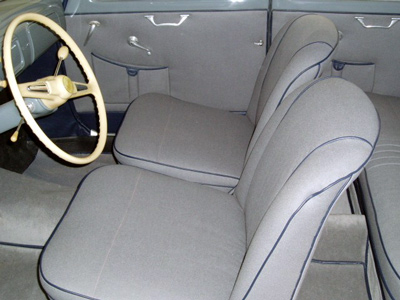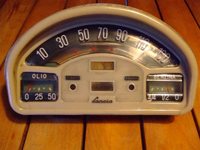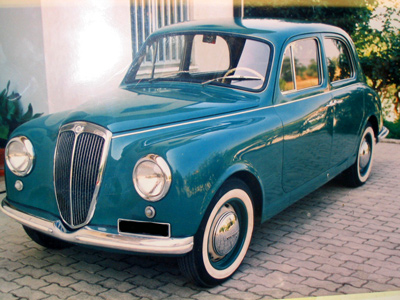The Appia 1st Series Berlina (Click here to read about the Series II) was first presented to the public in 1953. and replaced the earlier little Ardea, also dubbed “Lancia’s small luxury car.” Its introduction followed that of the larger luxurious Aurelia. The Appia was produced in three distinct series: The Appia 1st series (1953-1956), the 2nd series (1956-1959) and the 3rd Series (1959-1962). The legendary Fulvia ultimately replaced the Appia in 1963.
This “mid-size” sedan was eagerly awaited by the “upper-middleclass” Lancisti of postwar Italy, who saw the Appia as a mini-Aurelia. The Appia was throughout all production runs a relatively expensive car, one fourth the price of a new Ferrari. (costing in 1956 about Lit. 1.384.000 – at a time when a Ferrari 250 Gran Turismo Coupe Pininfarina cost Lit. 6.000.000 ). In Italy it suffered from strong competition by the almost identically priced, but much more sportier performing, Alfa Romeo Giulietta, and the rather mundane FIAT 1100/103 (that in1956 could be purchased for Lit 890.000).
Coachwork
The Appia 1st Series Berlina is a car with sober but harmonious classic lines, indeed a car reminiscent of the elegant and larger Aurelia. The car’s trim is, except for the chrome front grill surrounding, all made of aluminum; bumpers are also made of lightweight aluminum and, similar to the earlier Aprilias and Ardeas. As such they are particularly vulnerable to damage during parking – thin rubber strips would only be of little help in avoiding the almost unavoidable dents. The car appears relatively narrow as it measures a width of 1420 mm (55 inches) and overall length of 3865 mm (152 inches); maximum height is 1422 mm (56 inches) and clearance 160 mm (6 inches). The Appia is unit-body construction. The strong point of the Appia 1st Series Berlina is found in quality of interior and coachwork.

|
The car’s exterior is enhanced by the absence of welding spots between flanks and main chassis structure - all four fenders are bolted on and the junctures are covered by a fine aluminum strip that runs from the radiator over the doors to the very tail end of the car. This strip “stretches” the sides of the car and makes fender replacement an easy job!
Interior
In the tradition of Lancia, the Appia 1st Series Berlina has a well-built interior, but it avails from rather awkward period ergonomics.
The interior is not overly spacious but comfortable for both driver and front passenger who are provided with separate seats. Inside we find no armrests on the doors that thus have to be closed by grasping utterly simple folding handles similar to those that would also appear on the FIAT 600 and the 500. There is a flat metal dashboard without any padding that is sprayed in the color of the car’s bodywork. The glove box is in front of the passenger; the ashtray is centrally placed, with immediately below of it a special area reserved for the costly (Condor) radio.

|
Instruments and controls
The instrument cluster is executed in light colored plastic material, similar to that used for the steering wheel. The readability of the cluster (scaled at 130 km/hr) leaves much to be desired and is barely sufficient as there is no clock, water temperature meter and no tachometer; however, there is an oil pressure meter, a fuel level indicator and warning lights for the dynamo and the fuel reserve. This “modern” cluster is not an improvement over that of earlier Aprilias or Ardeas.

|
The hood release lever is positioned under the dashboard, as is the heater. The hand brake, choke and manual-accelerator knobs are located under the dashboard panel. A lighted turn signal knob is located uncomfortably on the dashboard in a near central position (just above the knob for the window wipers); its design follows that of the older (prewar) Ardeas and the FIATs Millecento and would be used equally in many of the FIAT group’s industrial trucks until the late Sixties. By pressing the “buttons” positioned on the steering wheel’s “spokes” one operates the horn.
Engine
The Appia 1st series is powered by a narrow V4 (10 degrees) water cooled engine of 1090 cc that with a 7.4:1 compression is good for 38 HP (34.9 HP/liters) at 4800 revs with 7.2 kgm torque at 3000 rpm. Engine displacement is slightly larger than that of the Ardea and less than that of the Aprilia.
The V4 featured a cast iron monobloc assembly with a virtually square aluminum head. Unique inlet and exhausts path were cast into the head enabling the carburetors to be placed on one side of the head and the exhaust manifold on the other.
Gearbox
The Appia 1st series has a steering column mounted gearshift mechanism that commands a four shift gear box, plus reverse; 1st and 2nd gears are positioned away from the driver – first up and second opposite down to first gear position, while 3rd and 4th fears are engaged by pulling the lever upwards from its neutral position to third gear and respectively down to fourth gear; reverse is engaged by pulling the gear lever from neutral to the driver and then downward.
Suspension and brakes
Front suspension follows the principles of Lancia’s patented shock-absorbing sliding pillars. Hydraulic drum brakes are mounted on all four corners. The rear axle is a live center differential supported by leaf springs and tubular shock absorbers.
On the road
Once seated in the Appia 1st Series, the driver notes at first that the visibility is poor in all but the direction immediately ahead, and therefore much similar to that of the earlier Aprilias and Ardeas, or, for that matter the contemporary Aurelia Berlinas and Coupes.
Rear seat passengers lack legroom and the press of the early Fifties unanimously concurred that some additional centimeters (inches) of platform length and width would form a welcome improvement particularly for adult passengers of above average length – as well as for average sized people wearing winter clothing!
Accessibility to the interior is excellent though as doors open spaciously in typical Lancia fashion (Aprilia, Ardea and Aurelia), and thus without a central pillar between front and rear door. The 1st Series Berlina’s trunk is small - upright mounted spare wheel, while battery compartment/gas tank are housed under the floor. The trunk is insufficient for luggage of four passengers on an extended trip. The loading capacity shortage is confirmed by the constructor’s weight data that are 930 kilograms for the car, which increases to 1155 kilograms with 4 passengers and a full gas tank. Hence the maximum luggage allowance is set at a whopping 5 (five!) kilograms - 50 kilograms (or more) would be far more appropriate!

|
Performance
The Appia 1st Series Berlina performs well on the road, as the car is stable even when driven fast around corners. The car’s acceleration and top speed are however rather disappointing and the Appia does not meet the period standards set by other cars - in particular the Giulietta. Maximum speed with four passengers on board is about 120 km/hr, (75 mph) a speed that is reached from standstill in about 75 seconds, while the 100 km/hr (62mph) threshold is reached in about 30 seconds. The car holds well in today’s traffic on town and country roads, whereby it allows for cruising speeds of 105 kilometers (about 68 mph) per hour. Fuel consumption is moderate; depending on a more or less sporty driving style, fuel consumption may range from 12.5 to 10 km/liter (or approximately 29 to 23 miles per US gallon). A full tank of gas contains 38 liters (or about 10 US Gallons) and is therefore sufficient for about a 400 kilometers trip (equivalent to about 250 miles).
The Appia 1st Series Berlina was not the commercial success that Lancia management had hoped for in the early to mid-Fifties. In those days, the Appia’s major handicap was without any doubt its price.
Three years after the introduction of the Appia, the Italian automobile magazine Quattroroute concludes in its road test of the Appia 1st Series Berlina (Quattroruote No.2, March 1956): “The Appia 1st Series Berlina performs not at the top of its category”; also, the magazine finds the car’s design had by that time shown its age, and concludes that the Appia Berlina 1st Series had definitely lost its attraction to the global motoring public as well as to the most passionate of the passionate “Lancisti”. In its summary the test team concludes that the difference that once justified the purchase of an Aprilia above a FIAT 1500 (6 cylinder) did not apply to the Appia 1st series when compared to the FIAT 1100/103, hence insinuating that purchase of a cheap FIAT 1100/103 made a lot of sense. The commercial picture was far gloomier in countries other than Italy. The Appia (much alike any other Lancia) was a rarity on the road, a usually purchased by people that made more than an average household income and had some affinity to Italy and/or its culture.
The world was ready for the Series II.
Next week: The restoration of a Series I Appia Sedan.



